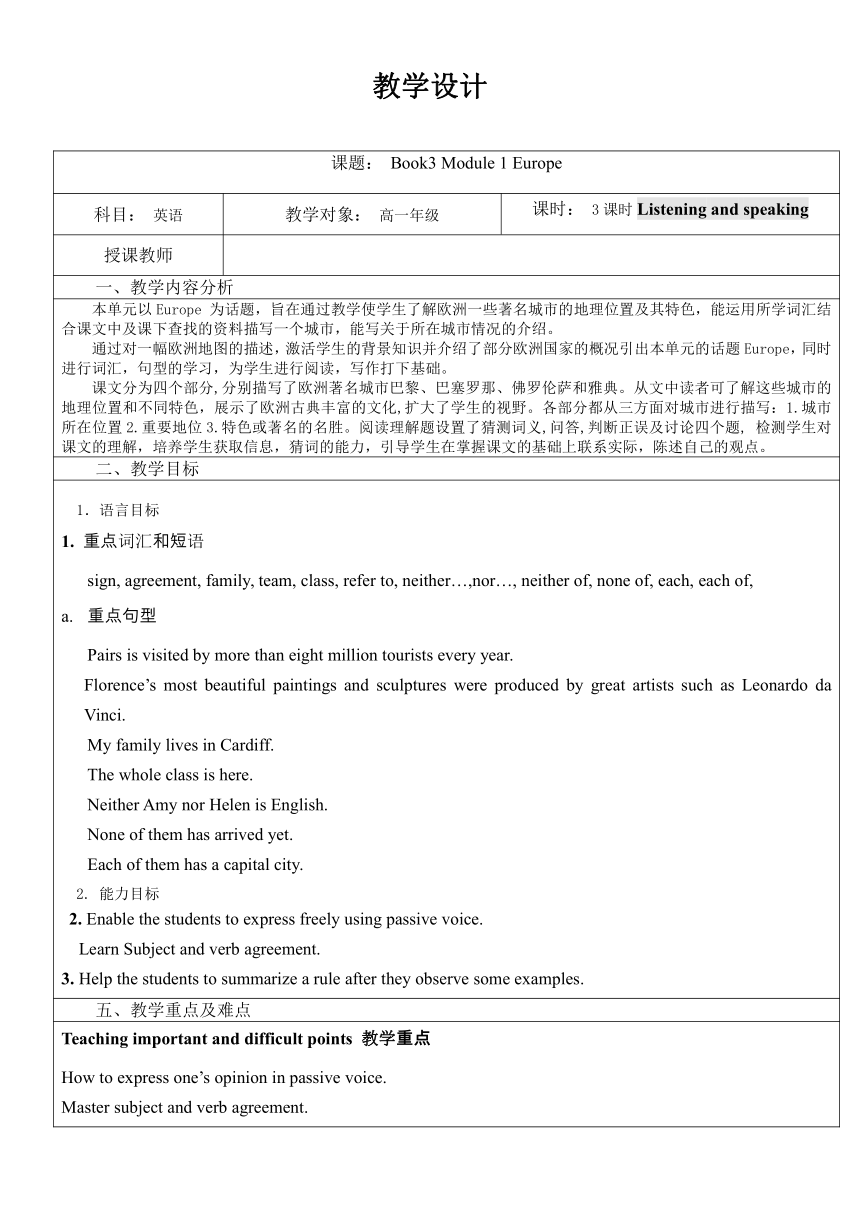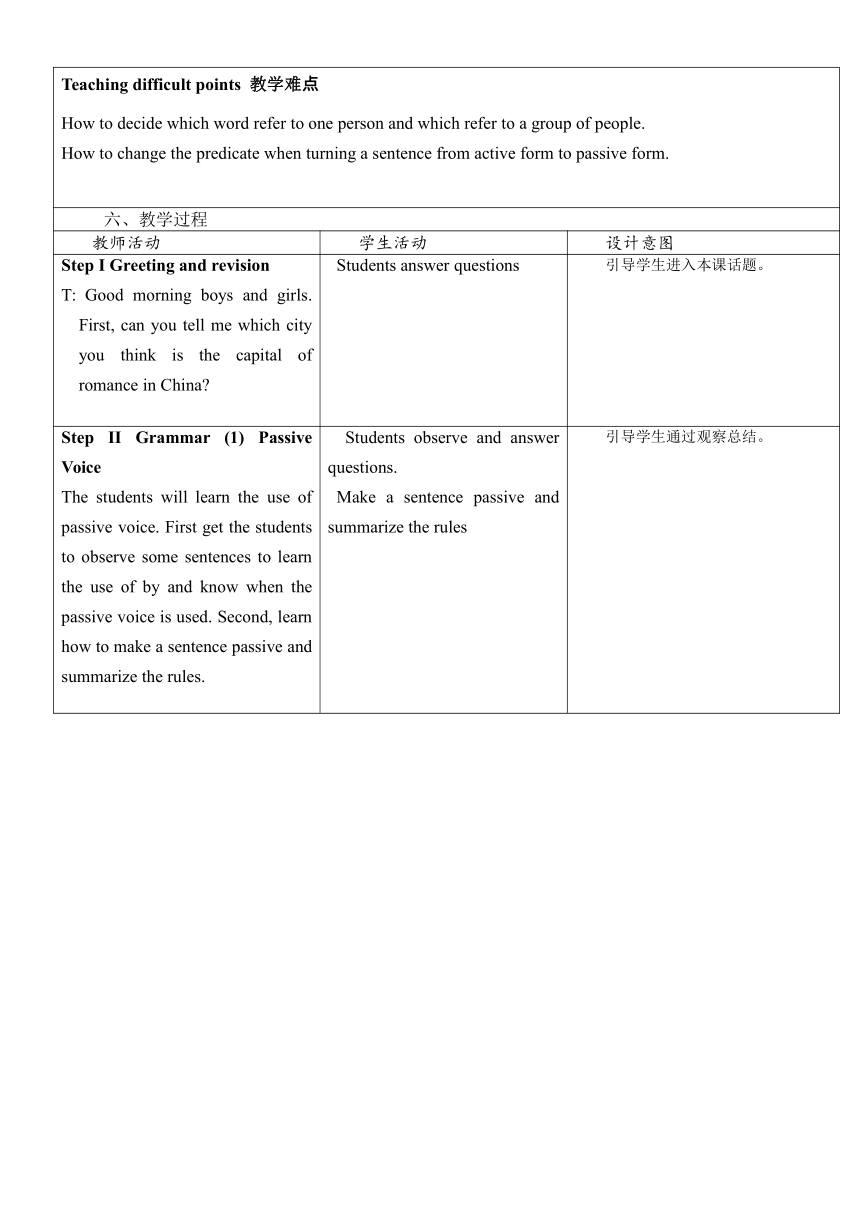外研版必修3 Module 1 Europe Language study教学设计(表格式)
文档属性
| 名称 | 外研版必修3 Module 1 Europe Language study教学设计(表格式) |  | |
| 格式 | zip | ||
| 文件大小 | 40.0KB | ||
| 资源类型 | 教案 | ||
| 版本资源 | 外研版 | ||
| 科目 | 英语 | ||
| 更新时间 | 2022-07-11 16:09:15 | ||
图片预览


文档简介
教学设计
课题: Book3 Module 1 Europe
科目: 英语 教学对象: 高一年级 课时: 3课时Listening and speaking
授课教师
一、教学内容分析
本单元以Europe 为话题,旨在通过教学使学生了解欧洲一些著名城市的地理位置及其特色,能运用所学词汇结合课文中及课下查找的资料描写一个城市,能写关于所在城市情况的介绍。 通过对一幅欧洲地图的描述,激活学生的背景知识并介绍了部分欧洲国家的概况引出本单元的话题Europe,同时进行词汇,句型的学习,为学生进行阅读,写作打下基础。 课文分为四个部分,分别描写了欧洲著名城市巴黎、巴塞罗那、佛罗伦萨和雅典。从文中读者可了解这些城市的地理位置和不同特色,展示了欧洲古典丰富的文化,扩大了学生的视野。各部分都从三方面对城市进行描写:1.城市所在位置2.重要地位3.特色或著名的名胜。阅读理解题设置了猜测词义,问答,判断正误及讨论四个题, 检测学生对课文的理解,培养学生获取信息,猜词的能力,引导学生在掌握课文的基础上联系实际,陈述自己的观点。
二、教学目标
1.语言目标1. 重点词汇和短语sign, agreement, family, team, class, refer to, neither…,nor…, neither of, none of, each, each of,重点句型 Pairs is visited by more than eight million tourists every year.Florence’s most beautiful paintings and sculptures were produced by great artists such as Leonardo da Vinci.My family lives in Cardiff.The whole class is here.Neither Amy nor Helen is English.None of them has arrived yet.Each of them has a capital city.2. 能力目标 2. Enable the students to express freely using passive voice. Learn Subject and verb agreement. 3. Help the students to summarize a rule after they observe some examples.
五、教学重点及难点
Teaching important and difficult points 教学重点How to express one’s opinion in passive voice.Master subject and verb agreement.Teaching difficult points 教学难点How to decide which word refer to one person and which refer to a group of people.How to change the predicate when turning a sentence from active form to passive form.
六、教学过程
教师活动 学生活动 设计意图
Step I Greeting and revisionT: Good morning boys and girls. First, can you tell me which city you think is the capital of romance in China Students answer questions 引导学生进入本课话题。
Step II Grammar (1) Passive VoiceThe students will learn the use of passive voice. First get the students to observe some sentences to learn the use of by and know when the passive voice is used. Second, learn how to make a sentence passive and summarize the rules. Students observe and answer questions. Make a sentence passive and summarize the rules 引导学生通过观察总结。
Step III PracticeT: Now make these sentences passive. Let’s see who completes the task well. Get the students to change the sentences in Part 2 P5. Then check the answers with the whole class.T: The following statements in Part 3 are wrong. Please correct them. Before doing it, read the example first. Get the Ss to do Ex1 individually. Make sure they know how to this exercise, then call out some students to read their answers. 初步让学生反馈所观察的结果。
Step IV Grammar (2) Subject and verb agreementTo learn collective noun.T: Turn to P7. Read the sentences in Part 1 and answer question: What have the words family, team and class got in common There are four points for you to choose in Page 97. Read and then tick the right ones.(Make sure the students know the meaning of ”in common”. ) After Ss finish it , check their answers in class. 该环节是学生对所学知识的运用环节,学生尝试创造性地使用目标知识。
Step V Practice T: Let’s rewrite the sentences in part 4 using neither, none or each. (T shows how to rewrite the sentences , making sure that the students know how to do this exercise.) After they finish rewriting the sentences, check their answers in class. 经过课堂上的词汇和情感输入, 学生独立完成写作任务,将本课话题深入并升华。
Step Ⅵ HomeworkTranslation.Translate the following sentences into English.花已经浇过了. (The flowers have already been watered.)这些树是五年前栽的.(These trees were planted five years ago.)计划将在月底完成.(The plan will have been completed by the end of this month.)我们的建议已经讨论了.(Our suggestion has already been discussed.)这本书已经译成了英语.(This book has already been translated into English.)Find a map of southeast Asia. Work in groups of four. Read the map and disc ss the following: --- countries you want to visit --- cities and tourist attractions you want to see-- -things you want to see--- where you start and finish your voyage 学生课后独立完成作业。 让学生巩固所学内容。
课题: Book3 Module 1 Europe
科目: 英语 教学对象: 高一年级 课时: 3课时Listening and speaking
授课教师
一、教学内容分析
本单元以Europe 为话题,旨在通过教学使学生了解欧洲一些著名城市的地理位置及其特色,能运用所学词汇结合课文中及课下查找的资料描写一个城市,能写关于所在城市情况的介绍。 通过对一幅欧洲地图的描述,激活学生的背景知识并介绍了部分欧洲国家的概况引出本单元的话题Europe,同时进行词汇,句型的学习,为学生进行阅读,写作打下基础。 课文分为四个部分,分别描写了欧洲著名城市巴黎、巴塞罗那、佛罗伦萨和雅典。从文中读者可了解这些城市的地理位置和不同特色,展示了欧洲古典丰富的文化,扩大了学生的视野。各部分都从三方面对城市进行描写:1.城市所在位置2.重要地位3.特色或著名的名胜。阅读理解题设置了猜测词义,问答,判断正误及讨论四个题, 检测学生对课文的理解,培养学生获取信息,猜词的能力,引导学生在掌握课文的基础上联系实际,陈述自己的观点。
二、教学目标
1.语言目标1. 重点词汇和短语sign, agreement, family, team, class, refer to, neither…,nor…, neither of, none of, each, each of,重点句型 Pairs is visited by more than eight million tourists every year.Florence’s most beautiful paintings and sculptures were produced by great artists such as Leonardo da Vinci.My family lives in Cardiff.The whole class is here.Neither Amy nor Helen is English.None of them has arrived yet.Each of them has a capital city.2. 能力目标 2. Enable the students to express freely using passive voice. Learn Subject and verb agreement. 3. Help the students to summarize a rule after they observe some examples.
五、教学重点及难点
Teaching important and difficult points 教学重点How to express one’s opinion in passive voice.Master subject and verb agreement.Teaching difficult points 教学难点How to decide which word refer to one person and which refer to a group of people.How to change the predicate when turning a sentence from active form to passive form.
六、教学过程
教师活动 学生活动 设计意图
Step I Greeting and revisionT: Good morning boys and girls. First, can you tell me which city you think is the capital of romance in China Students answer questions 引导学生进入本课话题。
Step II Grammar (1) Passive VoiceThe students will learn the use of passive voice. First get the students to observe some sentences to learn the use of by and know when the passive voice is used. Second, learn how to make a sentence passive and summarize the rules. Students observe and answer questions. Make a sentence passive and summarize the rules 引导学生通过观察总结。
Step III PracticeT: Now make these sentences passive. Let’s see who completes the task well. Get the students to change the sentences in Part 2 P5. Then check the answers with the whole class.T: The following statements in Part 3 are wrong. Please correct them. Before doing it, read the example first. Get the Ss to do Ex1 individually. Make sure they know how to this exercise, then call out some students to read their answers. 初步让学生反馈所观察的结果。
Step IV Grammar (2) Subject and verb agreementTo learn collective noun.T: Turn to P7. Read the sentences in Part 1 and answer question: What have the words family, team and class got in common There are four points for you to choose in Page 97. Read and then tick the right ones.(Make sure the students know the meaning of ”in common”. ) After Ss finish it , check their answers in class. 该环节是学生对所学知识的运用环节,学生尝试创造性地使用目标知识。
Step V Practice T: Let’s rewrite the sentences in part 4 using neither, none or each. (T shows how to rewrite the sentences , making sure that the students know how to do this exercise.) After they finish rewriting the sentences, check their answers in class. 经过课堂上的词汇和情感输入, 学生独立完成写作任务,将本课话题深入并升华。
Step Ⅵ HomeworkTranslation.Translate the following sentences into English.花已经浇过了. (The flowers have already been watered.)这些树是五年前栽的.(These trees were planted five years ago.)计划将在月底完成.(The plan will have been completed by the end of this month.)我们的建议已经讨论了.(Our suggestion has already been discussed.)这本书已经译成了英语.(This book has already been translated into English.)Find a map of southeast Asia. Work in groups of four. Read the map and disc ss the following: --- countries you want to visit --- cities and tourist attractions you want to see-- -things you want to see--- where you start and finish your voyage 学生课后独立完成作业。 让学生巩固所学内容。
